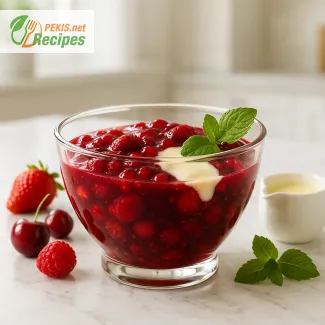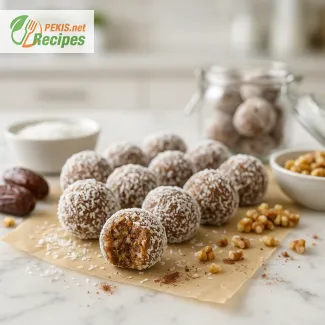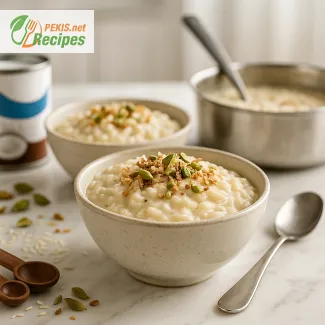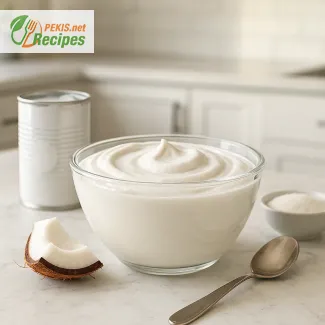Serves 4, prep 10 min, cook 10 min, total 20 min. A smooth fruit sauce (coulis) made from fresh berries, sugar, and lemon juice delivers a vibrant balance of sweet and tart flavors. This silky topping enhances cheesecake, ice cream, cakes, and breakfast bowls, adding both color and freshness. Naturally gluten free and easy to store, it keeps 2 days at room temperature, up to 1 week in the fridge, or 2 months in the freezer. Versatile and elegant, it transforms simple desserts into something special.
PEKIS – professional chef and recipe developer with more than 25 years of experience, specialized in European and international cuisine. I’ve worked with countless fruit-based desserts, from classic French patisserie to modern plated sweets, and I know how much a silky fruit coulis can elevate even the simplest dish. Over the years, I’ve tested different berry combinations, adjusted sweetness levels, and perfected the straining process to achieve that smooth, vibrant sauce you see in fine dining restaurants. This recipe is shaped by that hands-on practice, giving you a reliable way to bring professional flavor and texture into your own kitchen.
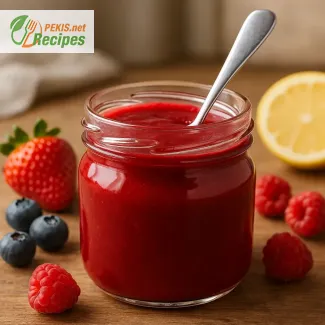
Perfectly Smooth Fruit Sauce for Elegant Desserts
A versatile coulis that enhances cheesecakes, ice creams and more
A fruit sauce (coulis) instantly transforms a simple dessert into something refined, adding a layer of freshness, natural sweetness, and vibrant color. This smooth purée made from ripe fruit is widely used in cheesecakes, ice creams, layered cakes, panna cotta, mousses, and even breakfast bowls. Its appeal lies in the balance of tart and sweet flavors, creating contrast that complements creamy or rich desserts. Whether poured over a slice of cheesecake, drizzled on a pavlova, or swirled through yogurt, a well-made coulis brings a professional finish to homemade treats.
Originating from classic French cuisine, the coulis was traditionally prepared from strained fruits or vegetables to achieve a silky texture free from seeds or pulp. Over time, it became most associated with fruit desserts, especially during the rise of modern patisserie in the 18th and 19th centuries. Today, the coulis is celebrated worldwide for its elegance, versatility, and ability to enhance both traditional and contemporary recipes.
Why you will love this recipe
- Fresh and vibrant flavor that highlights seasonal fruits
- Silky texture for a professional finish on cakes and plated desserts
- Naturally adaptable to strawberries, raspberries, blueberries, mangoes, or mixed fruits
- Quick to prepare, yet impressive in presentation
- Perfect balance of sweet and tart notes for contrast with creamy bases
Culinary characteristics of fruit coulis
The beauty of a coulis lies in its ability to adapt to the chosen fruit. Strawberries and raspberries provide bright acidity, perfect for cutting through rich cheesecakes. Blueberries and blackberries give a deeper, earthy sweetness with jewel-toned colors. Mango, passion fruit, or pineapple create tropical variations with exotic aromas. A small addition of citrus juice lifts the flavor, while a touch of sugar enhances natural sweetness without overpowering. Some cooks also use a drop of vanilla extract or liqueur to build complexity.
To achieve the signature smooth consistency, the sauce is typically blended and strained, ensuring a glossy, velvety finish. This makes it more refined than simple compotes or jams, aligning it with the traditions of haute cuisine while remaining accessible for everyday home cooking.
Storing and making ahead
- At room temperature: up to 2 days if sealed properly
- Refrigerated: 5–7 days in an airtight container
- Frozen: up to 2 months, thaw overnight in the fridge before use
- Reheating: gently warm in a saucepan or oven at 150 °C (300 °F) for 8–10 minutes, stirring lightly to restore smoothness
Creative variations with fruit coulis
- Mixed berry medley: blend raspberries, blueberries, and blackberries for layered flavor and rich purple tones
- Citrus-bright coulis: add orange zest or lemon juice for extra freshness
- Exotic tropical style: mango and passion fruit for a golden, fragrant finish
- Herbal infusion: pair strawberries with basil or raspberries with mint for a gourmet twist
- Chocolate pairing: swirl into chocolate mousse or drizzle over brownies for a rich contrast
How to use fruit sauce across desserts
- Drizzle over classic New York cheesecake to add color and tang
- Pair with vanilla ice cream for a simple yet elevated treat
- Serve alongside soufflés or molten lava cakes for balance
- Add as a topping to yogurt parfaits, chia puddings, or breakfast oats
- Use as a base layer in layered trifles or glass desserts
- Create artistic plate designs in fine dining style by streaking coulis with a spoon or squeeze bottle
Enticing serving possibilities with fruit coulis in modern cuisine
The adaptability of coulis extends beyond desserts. Some chefs use it with savory elements like roasted meats paired with berry coulis, where acidity cuts through richness. For festive occasions, coulis can be layered in clear glasses with whipped cream and sponge for a quick, elegant parfait. At weddings or celebrations, it often appears as a drizzle on plated desserts, giving a luxurious restaurant-style impression.
By preparing a versatile fruit sauce (coulis), every home cook gains access to a culinary tool that instantly refines desserts, breakfast dishes, and even creative savory pairings. Its elegance lies in simplicity: a purée of fresh fruit transformed into a silky, jewel-colored sauce that elevates every dish it touches.
- Rinse the fresh berries thoroughly and remove any stems or leaves.
- Place the berries, sugar, lemon juice, and water into a saucepan.
- Cook over medium heat for about 8–10 minutes, stirring occasionally until the fruits soften and release their juices.
- Remove from heat and allow to cool slightly.
- Transfer the mixture to a blender and blend until completely smooth.
- Strain the sauce through a fine sieve to remove seeds and pulp, leaving a silky, smooth coulis.
- Stir in vanilla extract to enhance the flavor.
- Allow the sauce to cool before serving. It can be served warm or chilled depending on preference.
- Store in an airtight container in the refrigerator or freeze for later use.
FAQ questionWhat is fruit coulis?
A coulis is a smooth, seedless fruit sauce made by simmering fruit with a little sugar and acid, blending until silky, and straining for a refined texture. Unlike a chunky compote or jam, a coulis stays pourable and glossy, perfect for cheesecake, ice cream, panna cotta, cakes, and breakfast bowls.
FAQ questionCan I use frozen fruit?
Yes—frozen berries work beautifully. Thaw briefly or cook straight from frozen; they release more juice, so simmer a few extra minutes to concentrate flavor. Choose fruit with no added sugar, and sweeten to taste at the end once the sauce cools slightly.
FAQ questionHow do I thicken or thin the sauce?
For thicker coulis, simmer on low to reduce by 2–4 minutes after blending, or whisk in a tiny cornstarch slurry (2–3 g cornstarch mixed with cold water) and cook 30–60 seconds until glossy. To thin, stir in warm water or lemon juice a teaspoon at a time for balanced acidity and flow.
FAQ questionDo I need to strain it?
For a classic finish, yes. Straining through a fine sieve removes seeds and pulp, giving a silky, seedless texture and a clean look on plated desserts. If you prefer a rustic style or want the extra fiber, you can skip straining—just blend thoroughly for smoothness.
FAQ questionHow long does it keep and how do I reheat it?
Store in an airtight container: room temperature up to 2 days, refrigerated 5–7 days, or frozen up to 2 months. Thaw overnight in the fridge. Reheat gently at 150 °C (300 °F) for 8–10 minutes or on low heat in a saucepan, stirring to restore a smooth, glossy consistency.
FAQ questionCan I reduce the sugar or use alternatives?
Absolutely. Start with less sugar, then adjust to taste once cooled (cold sauce tastes less sweet). For alternatives, use honey, maple syrup, or erythritol; add gradually and balance with lemon juice so the coulis stays bright, not flat.
FAQ questionWhy is my coulis watery or dull, and how do I fix it?
Watery coulis comes from excess liquid or under-reduction—simmer a bit longer after blending. If flavor seems flat, add a pinch of salt and a touch more lemon juice to lift the fruit. For dull color, avoid overcooking and cool quickly, then store covered to keep that vibrant, jewel-toned look.
A fruit sauce (coulis) brings together the simplicity of ripe berries and the elegance of a smooth, refined finish. With just a handful of ingredients and minimal cooking time, it delivers a burst of freshness that instantly elevates desserts. The balance of sweetness, tartness, and silky texture makes it a timeless addition to both classic and modern dishes.
Versatility is what makes this coulis so valuable. It pairs seamlessly with cheesecake, ice cream, sponge cakes, mousses, and even breakfast bowls, while also adapting to savory presentations where acidity balances richness. Whether served warm for comfort or chilled for a refreshing accent, the sauce remains adaptable to the occasion.
Consistency and flavor are key. By straining for smoothness and adjusting sugar or citrus for balance, every batch of coulis can be tailored to highlight the fruit at its best. Using seasonal produce ensures the sauce is not only flavorful but also vibrant in color, adding visual appeal to every plate.
Longevity is another strength. Stored properly, this coulis keeps well for days in the refrigerator and even longer in the freezer, making it a convenient option for planning ahead. A single batch provides multiple servings, ready to transform simple treats into memorable creations.
At its core, a silky, jewel-toned fruit coulis is more than a sauce—it’s a finishing touch that turns everyday desserts into something special, a detail that reflects both care and creativity in the kitchen.
Allergens present in the recipe:
- None
- Gluten free
Tips for allergen and gluten replacements:
- This recipe is naturally free from gluten, dairy, nuts, and soy.
- If using flavored extracts, ensure they are certified gluten-free if required.
- For reduced sugar, substitute with a natural sweetener such as stevia or erythritol.
- Vitamin C: 35 mg – supports immune system and skin health
- Vitamin K: 9 µg – important for blood clotting and bone strength
- Folate (B9): 15 µg – contributes to cell formation and energy production
- Potassium: 180 mg – regulates fluid balance and supports heart function
- Manganese: 0.4 mg – essential for metabolism and bone development
- Anthocyanins: 120 mg – protect cells from oxidative stress and support cardiovascular health
- Ellagic acid: 15 mg – contributes to anti-inflammatory and anticancer properties
- Resveratrol: 1 mg – supports heart health and may slow down aging processes
